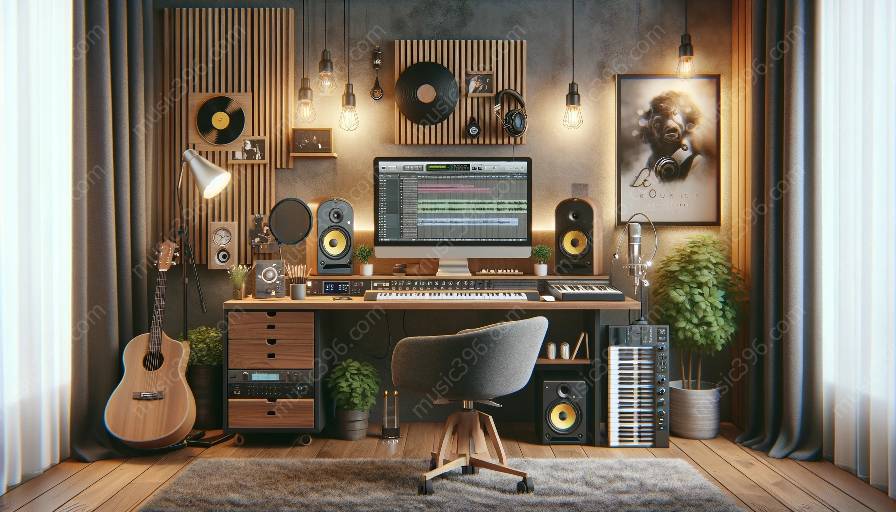Setting up a home studio involves more than just purchasing music equipment & technology. To ensure optimal sound quality, it is crucial to optimize acoustics in the home studio environment. This guide will provide a comprehensive understanding of acoustics, tips on setting up a home studio, and recommendations for choosing the right music equipment & technology.
Understanding Acoustics
Acoustics refers to the science of sound and its transmission. In a home studio environment, acoustics play a critical role in shaping the quality of recorded and produced audio. Poor acoustics can lead to issues such as unwanted reflections, reverberations, and frequency imbalances, resulting in a less-than-ideal listening experience.
Optimizing the Home Studio Environment
To optimize acoustics in a home studio environment, consider the following factors:
- Room Selection: Choose a room with minimal external noise and disturbance. Avoid small, square rooms, as they tend to produce standing waves and resonance issues.
- Acoustic Treatment: Invest in acoustic panels, diffusers, and bass traps to control reflections and absorb unwanted frequencies. Proper placement of acoustic treatment is crucial for achieving balanced acoustics.
- Speaker Placement: Position studio monitors and speakers in an equilateral triangle with the listening position. This setup helps create an accurate and consistent listening environment.
- Furniture Arrangement: Consider the placement of furniture such as couches, bookshelves, and desks, as they can affect sound dispersion and absorption within the room.
Home Studio Setup
Creating an effective home studio setup involves careful consideration of the following:
- Computer and Digital Audio Workstation: Select a powerful computer with sufficient processing power and RAM to handle audio recording, editing, and production tasks. Invest in a digital audio workstation (DAW) that meets your specific music production needs.
- Audio Interfaces and Monitors: Choose high-quality audio interfaces with low latency and studio monitors that provide accurate and transparent sound reproduction. Consider factors such as frequency response, dynamic range, and connectivity options.
- Microphones and Headphones: Invest in a variety of microphones suitable for different recording purposes, including vocal, instrument, and room miking. Additionally, acquire studio-quality headphones for monitoring and mixing purposes.
- Outboard Gear and Signal Processing: Explore the use of outboard gear such as preamps, compressors, and equalizers for enhancing the sonic characteristics of recorded audio. Familiarize yourself with signal processing techniques within the DAW environment.
Choosing the Right Music Equipment & Technology
When selecting music equipment and technology for your home studio, it's essential to prioritize quality, functionality, and compatibility:
- Instrumentation: Invest in high-quality musical instruments such as guitars, keyboards, and drum kits to ensure the best possible source recordings.
- Virtual Instruments and Plugins: Explore a diverse range of virtual instruments and audio plugins to expand your sonic palette and creative potential within the DAW environment.
- Audio Cables and Connectivity: Prioritize reliable audio cables and connectors to minimize signal loss and interference between various components of your home studio setup.
- Room Correction and Calibration: Consider implementing room correction and calibration systems to optimize the interaction between your studio monitors, acoustic environment, and listening position.
- Backup and Data Management: Develop a robust backup and data management strategy to protect your music projects, audio recordings, and digital assets from unforeseen technical issues.
Improving Sound Quality
To enhance sound quality within your home studio, consider the following strategies:
- Acoustic Measurements: Utilize acoustic measurement tools and software to analyze the frequency response, reverberation time, and spatial characteristics of your studio environment. Make informed decisions based on objective data.
- Monitoring and Listening Tests: Conduct regular monitoring and listening tests to evaluate the accuracy and fidelity of your audio productions. Identify potential areas for improvement and fine-tuning.
- Mixing and Mastering Techniques: Familiarize yourself with advanced mixing and mastering techniques to achieve professional-grade audio results. Pay attention to aspects such as equalization, dynamics processing, and spatial imaging.
- Collaboration and Feedback: Seek feedback from trusted fellow musicians, producers, and audio engineers to gain valuable perspectives and refine your creative output.
- Continuous Learning: Stay updated with the latest advancements in recording technology, production methodologies, and industry standards to continuously enhance your skill set and sonic capabilities.
By optimizing acoustics in a home studio environment, setting up a conducive home studio, and choosing the right music equipment & technology, you can elevate the quality of your audio productions and create a professional-level music environment within the comforts of your own space.























































